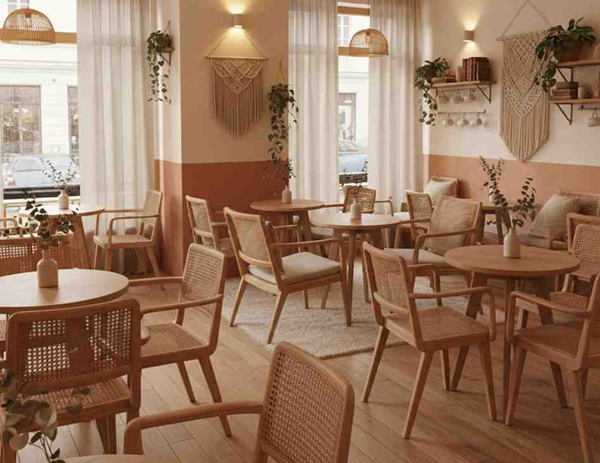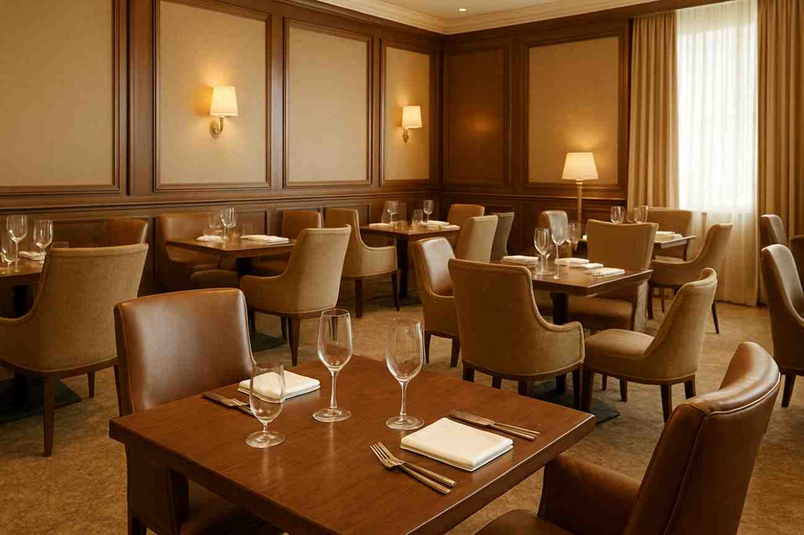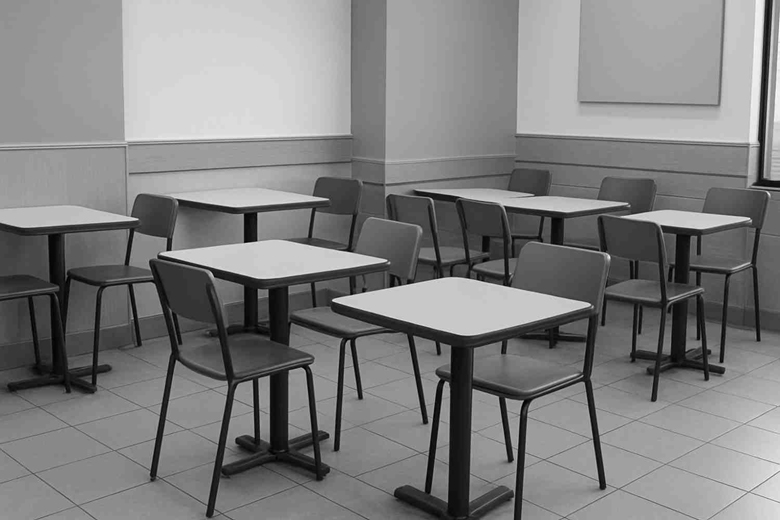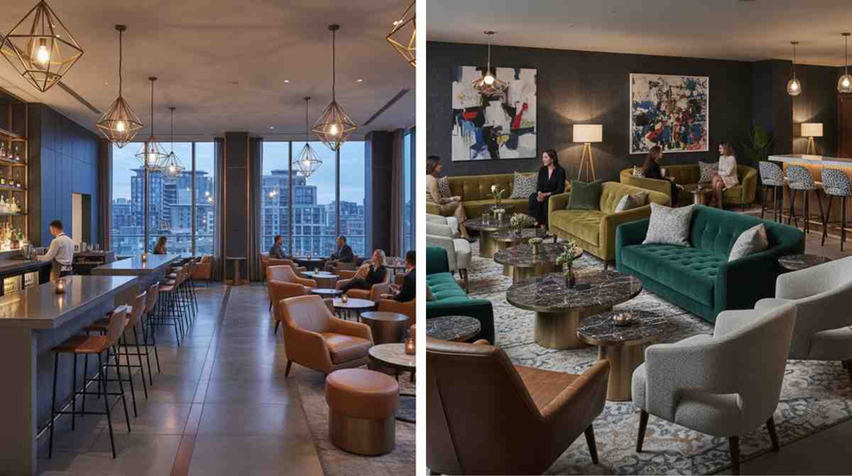How to Choose the Right Furniture for Your Restaurant Concept

When designing a restaurant, the right furniture can define the entire ambiance. It’s not just about filling space but creating an environment that reflects your restaurant’s identity, enhances customer comfort, and supports your brand vision. Whether it’s a cozy cafe, fine dining, or a modern eatery, the right furniture ensures a memorable dining experience.
In this blog, we’ll guide you on choosing the right restaurant furniture by understanding your concept, prioritizing comfort, functionality, and durability. We’ll also cover design alignment with your brand, space optimization, budget, sustainability, and furniture choices for cafes, fine dining, fast food, and more.
Understand Your Restaurant Concept
Before purchasing any furniture, it’s essential to have a clear understanding of your restaurant’s concept and theme. Every restaurant type has a unique atmosphere that determines the furniture style, comfort level, and even the color palette you should choose.
Ask yourself:
- What kind of dining experience do I want to offer — casual, formal, or fast-paced?
- Who is my target audience — families, professionals, or young adults?
- What emotions should my space evoke — warmth, sophistication, or energy?
Focus on Functionality and Comfort
Even the most visually appealing furniture won’t serve its purpose if it’s uncomfortable. Customers tend to spend more time — and come back more often — when the seating feels pleasant and supportive.
Key points to consider:
- Ergonomic design: Chairs should support posture and comfort, especially for longer dining durations.
- Table height: Standard dining tables are typically 29–30 inches high. Ensure the chair height complements this for comfortable seating.
- Spacing: Maintain at least 24–30 inches between tables for easy movement.
- Weight and flexibility: Lightweight chairs and tables make rearranging easier for events or larger groups.
Choose the Right Materials
Your choice of material affects both durability and aesthetics. It’s important to select materials that suit your restaurant’s ambiance and can withstand daily use.
| Material | Best For | Advantages | Considerations |
| Wood | Traditional or elegant spaces | Warm appearance, sturdy, timeless | May require periodic maintenance |
| Metal | Modern and industrial styles | Highly durable, easy to clean | Can feel cold or less cozy |
| Laminate | Fast-food or high-traffic restaurants | Scratch-resistant, affordable | Less luxurious appearance |
| Upholstery (Fabric/Leather) | Fine dining or lounges | Comfortable and premium look | Needs regular cleaning |
| Rattan/Wicker | Outdoor or themed cafés | Lightweight, trendy | Not ideal for heavy indoor traffic |
Match the Color and Design with Your Brand
Colors play a psychological role in dining experiences. The right tones can influence appetite, mood, and comfort.
Color suggestions based on restaurant type:
- Warm tones (reds, oranges, yellows): Stimulate appetite and energy — great for casual restaurants.
- Cool tones (blues, greens): Create a calming, relaxing atmosphere — perfect for fine dining.
- Neutrals (beige, brown, gray): Offer a sophisticated and timeless appeal for any concept.
When choosing design elements, ensure your furniture aligns with your interior decor — from wall textures to lighting fixtures. Consistency builds a stronger brand image and enhances customer perception.
Optimize Space Layout
Efficient layout planning ensures a balance between comfort and capacity. Crowding your dining area might allow more seats but reduces comfort — while too much space can make the place feel empty.
Layout tips:
- Create separate zones for different group sizes (2-seaters, 4-seaters, booths).
- Keep aisles wide enough for staff and guests to move freely.
- Place waiting areas or lounge seating near entrances.
- Use furniture with dual purposes (e.g., storage benches) for smaller spaces.
Durability and Maintenance
Restaurant furniture faces daily wear — from spills to movement and cleaning. Investing in durable, easy-maintenance materials saves long-term costs.
Durability checklist:
- Look for scratch- and stain-resistant surfaces.
- Ensure joints and welds are strong.
- Avoid fabrics that easily absorb liquids.
- Opt for replaceable upholstery if possible.
- Use protective pads on chair legs to prevent floor damage.
Lighting and Furniture Coordination
Lighting and furniture work hand-in-hand to define your restaurant’s vibe. For instance:
- Warm lighting complements wood or neutral-toned furniture.
- Cool white lighting enhances modern metal or minimalistic interiors.
- Accent lights (pendants, sconces) highlight key areas like booths or bar counters.
The goal is to create an inviting atmosphere where the furniture enhances — not competes with — your lighting scheme.
Budget and Value
Your budget doesn’t have to limit your creativity. With strategic planning, you can achieve a premium look without overspending..
Smart investment tips:
- Spend more on primary furniture like dining chairs and tables.
- Choose mid-range options for decor pieces and accessories.
- Consider reupholstering or refinishing existing furniture for a fresh look.
Sustainability in Furniture Choices
Sustainable furniture ideas:
- Use reclaimed wood or eco-certified materials.
- Choose recycled metal or bamboo furniture.
- Partner with suppliers who follow ethical manufacturing practices.
- Incorporate durable designs that reduce waste over time.
Restaurant Types and Furniture Selection
1. Cafe Furniture
Cafes need a relaxed, casual vibe that encourages customers to linger.
- Lightweight chairs and small tables for flexibility.
- Two- and four-seater options for small groups.
- Warm tones, wood, or rattan for coziness.
- Optional benches or lounge seating for comfort.

2. Fine Dining Furniture
Fine dining requires elegance, comfort, and privacy.
- Upholstered chairs in premium fabrics or leather.
- Sturdy wood tables with luxurious finishes.
- Spacious layout for privacy.
- Classic colors and designs aligned with the theme.

3. Fast Food / Quick Service Furniture
Fast-food setups prioritize practicality, durability, and efficiency.
- Easy-to-clean chairs and tables, often metal or laminate.
- Stackable or lightweight seating for flexibility.
- Bold colors and simple designs for a fast-paced vibe.

4. Outdoor / Terrace Furniture
Outdoor seating must be weather-resistant and functional.
- Rattan, wicker, or aluminum furniture for durability.
- Cushioned seating with water-resistant fabrics.
- Umbrellas, pergolas, or canopies for shade.
- Layout allowing easy movement and social interaction.

5. Bar & Lounge Furniture
Bars and lounges focus on style, comfort, and social interaction.
- High stools and bar tables for casual mingling.
- Plush lounge chairs and low tables for intimacy.
- Materials like leather, velvet, or polished wood.
- Accent pieces (ottomans, modular seating) for flexibility.

Why Choose Topform
Choosing a reliable furnishing partner saves time and ensures consistency. At Topform Furnishing, we provide end-to-end restaurant furniture in Dubai solutions — from concept design and material selection to installation and reupholstery.
Here’s why Topform is the ideal choice:
- Customize furniture to match your restaurant’s theme.
- Brings experience in restaurant projects for practical, elegant solutions.
- Provides samples and design consultations to visualize your space.
- Offers after-sales support and repair services for lasting quality.
Frequently Asked Questions (FAQs)
How do I choose the right furniture style for my restaurant?
Start by defining your restaurant’s theme and audience. Then select furniture styles, colors, and materials that complement that theme — for instance, minimalist designs for modern restaurants or warm wood tones for cozy eateries.
What’s the best material for restaurant furniture in dubai?
It depends on your restaurant type and budget. Wood is timeless and elegant, metal is durable and modern, and laminate is affordable and easy to maintain. A combination often works best.
How can I make small dining spaces look spacious?
Use light colors, slim-profile furniture, and mirrors to create an illusion of space. Round tables and transparent materials like glass can also make a compact area appear larger.
Should I buy ready-made or custom-made furniture?
Custom-made furniture allows you to tailor design, size, and materials to your exact needs — ideal for unique restaurant layouts or branding. Ready-made furniture, however, is faster and more budget-friendly.
How often should restaurant furniture be replaced or maintained?
With proper care, restaurant furniture can last 5–10 years. Regular cleaning, timely repairs, and reupholstery help maintain quality and aesthetics for longer.